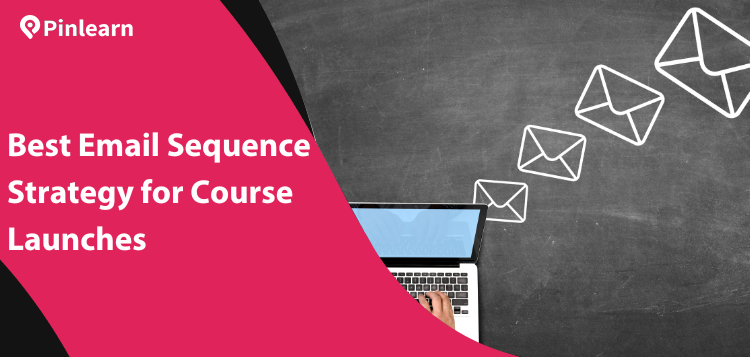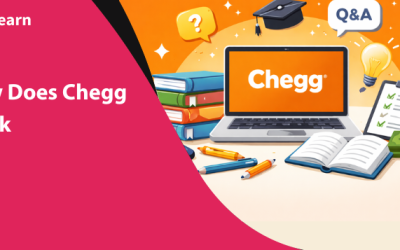Best Email Sequence Strategy for Course Launches
Launching your course sure is exciting! But the success of your course depends not only on the content, but also on how well you spread the word! One of the best ways to convert readers into buyers is email marketing.
Automated email sequences build curiosity, engagement and drive conversions. Crafting a perfect email sequence is part strategy and science. And, when you plan your email sequence well, you inform, nurture and guide your prospects easily through the funnel!
In this blog, we break down the 3-stage strategy to win that much-awaited yes.
So, let’s dive in!
What is an Email Sequence? Why is it Crucial for the Course Launch?
An email sequence is a series of automated emails sent to a specific audience based on specific actions and responses. So, email sequences are either based on time or actions. Time-based emails are sent once or twice a week.
Action-based sequences are sent when the user performs certain actions, like clicking a link, signing up for a newsletter, or abandoning the cart.
Why Email Sequences are Crucial for Course Launches?
Here’s why email sequences level up your course launch:
-
Personalized Communication
Be it the recipient’s name, personalized subject lines, or tailored content, email sequences are an excellent way of personalized communication. This makes your emails more engaging and relevant for users. Businesses can also tailor based on the user’s behaviour, preferences, and past history.
-
Saves Your Time
Automated email sequences eliminate repetitive, manual tasks and reduce the overwhelming work for the growing subscriber list. Emails are created and auto-scheduled to run in the background.
-
Nurture Leads and Build Authority
A blatant sales mail can be a major turn-off! Instead, a lead nurture email educates, informs, and guides learners to the purchase decision.
-
Smarter Segmentation and Targeting
Businesses can segment their audience based on demographics, engagement levels, and purchase history. Tailored messages resonate best with the audience and give higher engagement.
-
Improved Conversion Rate
When you strategically send email sequences over a period of time, you subtly lead them towards the purchase.
Types of Email Sequences
Want to elevate the impact of your course? Choose the type of email sequence based on your course goals and objectives.
Below we have listed the most common email sequences for course launch:
| Email Sequence Type | Purpose |
| Welcome Email Sequence | Designed to introduce your course to new subscribers in the mail list. Provide the step-by-step lessons of your course, access details, outline the course objective, timeline, and learning outcome. |
| Onboarding Email Sequence | Triggered post-purchase after the welcome mail. Typically, your “getting started email” with step-by-step guide, tips, and special offers to guide you through the course. |
| Abandoned Cart | Triggered when you add the course to cart, but didn’t complete the purchase. Gentle nudge or reminder, highlight reminders, and add urgency. |
| Re-engagement Campaign | Re-engagement emails sent to re-capture interest by highlighting value, social proof, or providing attractive offers. |
| Post-purchase Follow Up | Follow-up email for maintaining relationship after course purchase. This includes order confirmations, course recommendations, reminder, survey emails. |
| Feedback Request | Sent automatically after the course purchase asking feedback and the improvements in the course. |
Best Email Sequence Strategy for Course Launch: Proven Strategies
1. Pre-Launch Email
Purpose: Build early anticipation and talk about the problem and hint that your course will solve the problem.
Launching a course is a big decision as a course creator. But success becomes even sweeter when you spread the word out loud! Pre-launch emails build early hype about your course.
Consider this as warming up your audience before the actual launch. Every teaser image, video, and call to join the waitlist primes the audience for the launch day!
Email 1: Teaser announcement
Announce that something exciting is about to come up. Mention what the course covers and hint at the benefits. You can also send a series of teaser emails, like announcement, sneak peek, and countdown emails.
Example: “Get tuned for something exciting coming up soon! Our course is almost ready for launch. What if you could launch your AI agent in [X weeks]?[Unique Business proposition].
In this course, you’ll discover:
- AI agent frameworks
- Agent Engineering Setup
- Multi-LLM API Integration
Whether you’re an AI novice or an expert, you’ll gain valuable insights from this course.
Secure your spots early, before the doors close. Here’s the [registration link].”
Email 2: Lead Nurture (Problem awareness/ Case study)
Explain a relevant problem that your course solves (e.g., get more website traffic, learn AI). Lead nurturing emails typically guide from awareness, interest, trust and purchase phase.
These are different ways to send lead nurturing emails:
- Target pain points & write a relatable story or stat.
- Share a quick, actionable tip that learners can implement today.
- Highlight a case study, a success story, or a social proof explaining the transformation
- Share freebies like mini guides, checklists, templates, etc.
Example: “Struggling to get traffic to your website? Countless hours, tons of marketing funnels, thousands of dollars, all going down the drain. Yet, nothing’s converting. That’s when I came across this optimized funnel, and it really works!”
Share a scenario where the funnel actually worked.”
💡 Tip: Add a bite-sized lesson or quick win that you can try instantly. Try balancing education, inspiration, and connection.
Email 3: Content Updates
Hint about a new blog post, podcast, video, or social media post. Thus, you can share your knowledge and expertise with your target audience. It is a great way to demonstrate your domain authority.
Email 4: Sneak Peek
Share a sneak peek of your upcoming course and spark interest among the audience. Mention the brief highlights of key modules and highlights of the course. The key is to build curiosity and an “exclusive entry into the insiders club.”
💡 Pro Tip: Include a free checklist/template/ short video clip from your course in the mail. This proves the value and credibility of your course.
Email 5: Countdown Mail
Send a countdown email a day prior to the actual course launch. You need to remind, push and make them excited about the big day. Don’t miss these key elements — urgency, benefits or highlights, and CTA.
Use subject lines like “It’s almost time!”, “Only 24 hours left”. You can even add an actual countdown timer with HTML code or third-party countdown timers. End the mail with an early-bird bonus or discount, capturing interest.
2. Main Launch
Purpose: Get your course available to your audience. Create a sense of urgency & build credibility of your course.
Email 6: Launch Day
Your course hits the ground with a bang! Announce that your course is live and ask people to buy your course. Share the course details, modules, pricing and ultimate transformation. Clearly explain what’s included, the unique selling point, the bonus, and the link to the sales page.
Example: “We are thrilled to announce that we have finally opened enrollments for our “Cohort 30-Day Writing Course”! Whether you need to master writing for building your business or design a stunning ad copy, we would love to have you on board!
Here are the key highlights & benefits of the course:
- Writing in different languages
- Learn how to integrate AI into your writing workflows
- Covers every topic you could widely imagine(from business to AI to fashion)
The first cohort sets sail on Monday (29th September)!!!
Below is the full breakdown of what you gain in this course & curriculum….
We are offering an attractive discount for early adopters. Use the discount code to avail a discount on the course purchase.”
Email 7: Enrollment Call
This email works for a cohort-based course. Build a sense of urgency — “Last chance to enroll — spots filling fast!” Put forth the unique high points, such as exclusive content, projects, or community support.
Email 8: FAQ Handling
Building trust is an essential part of launching your course. An FAQ email can clear common questions & objections and build trust. You can cater to the common questions asked by users to guide them better to the course purchase. FAQ-handling mail is sent 2-3 days after the course announcement.
Here are a few common questions you can include in your mail:
- Who is the course for?
- What is the price and schedule of the course?
- What are the prerequisites of the course?
- Do you provide certifications after completing the course?
- Is there an active refund policy?
- Common objections- “What if I fall behind?” “What if I cannot afford it?”What if I don’t have enough experience?”
Email 9: Success Stories / Testimonials
Are your prospects on the fence? A convincing testimonial or success story can provide social proof and show the actual transformation. You could add either a short testimonial quote, a long story, a video testimonial, a case study, or a screenshot to build enough credibility.
Example: “When A joined my class, he was struggling with Meta Ads; he had already wasted $10,000 on it. The worst part was that they weren’t even converting! Fast-forward to today? Conversions have skyrocketed by 200% within a short time.”
Here’s her short video testimonial: [Testimonial]
Join my course and I’ll teach you the exact proven process to boost your sales through Meta ads.”
💡 Tip: Bust a common misconception like “too expensive”, “too busy”, or “not enough experience.”
Email 10: Final Call (Urgency & Limited Seats)
Of course, you won’t win all your customers on the first go. Most buyers wait to make a decision till the last 24- 48 hours. Hence, the final call for your course launch helps in urgency, clarity, and commitment! The key elements are benefits, transformation, and action-oriented CTA.
💡 Tip: Use time-stamped headlines like “6 hours left” or “enrollment closes by midnight.” Preferably send two messages under final call – morning and “final hours.”
3. Post-Launch Email
Purpose: Build customer loyalty, encourage repeat purchases, and deepen relationships. Also, it helps to provide valuable content, improve customer experience, and foster a strong community.
Email 11: Thank You Email
A simple “thank you” goes a long way to appreciate and reassure buyers that they made the right decision. It goes a long way to drive a positive impression, confirm your purchase, and highlight the next steps. Share the essential login credentials to access the course. Assure them that “you’re not alone in the journey.” Mention social group, live call or networking opportunities to foster a sense of community.
Email 12: Upsell/Cross-sells Emails
Want to generate more income through your course launch? Upselling a premium or upgraded version of your course offers the best value to your customers. Similarly, adding a 1-on-1 personalized coaching or complementary products provides a complete package.
💡 Tip: Position your upsell as the next step instead of another product. Sell it at an attractive deal for existing students to improve conversions!
Email 13: Feedback Request
Feedback emails provide valuable insights into how well your course resonates with your audience. You can even collect testimonials and case studies as social proof. It provides definite insights on how to improve your course and provide more value to learners.
Email 14: Course Engagement Mails
Ongoing engagement is essential to strengthen your relationship with your buyers.
Here are a few ideas for course engagement emails:
- Progress nudges/ Gamification
- Accountability check-ins
- Celebrations & milestone wins like module completions, consistent weekly completions, and full-course completions.
- Member/community spotlights
- Gamification triggers or motivation boosts
Email 15: Re-engagement Emails
Think about a learner who purchased the course, but dropped off mid-course or didn’t access the course at all. You can win them back by sending re-engagement emails. Acknowledge their brief period of inactivity and remind them why they joined the course in the first place. Start with a gripping subject line like “Still with us?” or “You don’t want to miss this!”
💡 Tip: Include an attractive incentive (checklist, template, or mini-guide) or create a sense of urgency with an upcoming deadline.
Wrapping Up
Building a great email sequence is a sure-fire formula for a smooth and seamless course launch! Before you create your email sequence, research your target audience well. An optimized market funnel to lead your prospects from awareness to the buying decision!
We have listed proven strategies to lead your prospects better! Include these hooks, CTAs, and subject lines to improve your course conversions!
So, are you ready to leverage these workflows and maximize your course sales?
FAQ-Related to Best Email Sequence Strategy for Course Launches
1. What is the best email sequence for course launch?
The best email sequence must spark curiosity, educate, and drive urgency about your course. A well-planned 3-phase framework includes a pre-launch sequence, launch day, and post-launch sequence to maximize engagement and conversions.
2. How many emails should I send for the course launch?
Plan a minimum of 6-7 mails (pre-launch, launch, post-launch phase) and a maximum of 12-13 mails, including teasers and follow-ups.
3. What are the tools for sending email sequences for course launch?
ActiveCampaign, MailerLite, ConvertKit, HubSpot, and MailChimp are popular software for email sequences.





